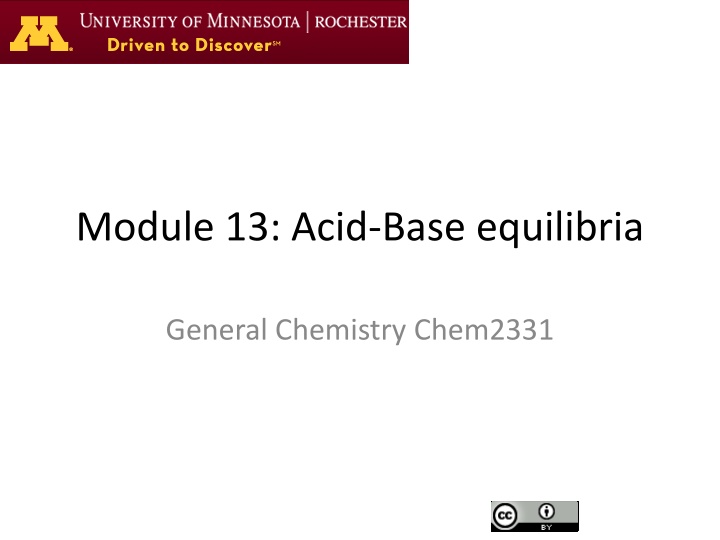
Acid-Base Equilibria in General Chemistry
Explore the concepts of acid-base equilibria, common bases, oxoanions from oxosalts, amphoteric substances, concentrations in equilibrium, and Lewis acids/bases in the realm of General Chemistry. Understand the characteristics of various bases, naming conventions for oxoanions, identification of amphoteric substances, and ranking of ion concentrations in aqueous solutions. Dive into the chemistry of acids and bases through informative visuals and detailed explanations.
Download Presentation

Please find below an Image/Link to download the presentation.
The content on the website is provided AS IS for your information and personal use only. It may not be sold, licensed, or shared on other websites without obtaining consent from the author. If you encounter any issues during the download, it is possible that the publisher has removed the file from their server.
You are allowed to download the files provided on this website for personal or commercial use, subject to the condition that they are used lawfully. All files are the property of their respective owners.
The content on the website is provided AS IS for your information and personal use only. It may not be sold, licensed, or shared on other websites without obtaining consent from the author.
E N D
Presentation Transcript
Module 13: Acid-Base equilibria General Chemistry Chem2331
Module 13 Module 13 Session 3 1. Video 1: 1. Bases: M(OH), RNH2, Oxosalts 2. Oxosalts in solution. Amphoteric substances 2. Video 2: Salts in solution have acid/base character 1. Finding and ranking concentration of ions in equilibrium 3. Video 3: Lewis Base and Lewis Acid Chem 2331: General Chemistry 2
Common Bases Common Base Type General Formula R-NH2 Examples Amino groups NH3, CH3NH2 CH3COO(-) (acetate ion) CH3CH2COO(-) (propionate) CO3(2-) (carbonate) PO4(3-) (phosphate) PO3(3-) (phosphite) NO2(-) (nitrite) SO3(2-) (sulfite) ClO2(-) (chlorite ion) ClO(-) (hypochlorite ion) Carboxylate R-COO(-) XOn(m-) Oxoanions (conjugate bases of weak oxoacids) HXnOm Strong bases Group I and II hydroxydes: Na(OH), K(OH), Rb(OH) Mg(OH)2, Ca(OH)2, Ba(OH)2 Notice that F(-), HS(-), S(2-) are all weak bases since they are the conjugate bases of weak acids Chem 2331: General Chemistry 3
Oxoanions (from oxosalts) Naming oxoanions Root Suffixes Examples Prefixes No. of O atoms per root ate ClO4- perchlorate Valence of Cl root ate ClO3- chlorate root ite ClO2- chlorite hypo root ite ClO- hypochlorite Carbonate Nitrate Nitrite Phosphate Phosphite Sulfate Sulfite
Partially deprotonated oxoacids: amphoteric substances An amphoteric substance is one that can behave like an acid or like a base depending on the strength of another substance to accept or donate the proton. Identify the amphoteric substances of partially deprotonated oxoacids.
Concentrations in equilibrium A lot of the charged species will be presented as salts. Rank in decreasing order the concentrations of ions in aqueous solutions Na3PO4 NaHSO3 Mg(OH)2 Mg(HCO3)2 Chem 2331: General Chemistry 6
Lewis acids and Lewis bases F F H H N + B B N HH F F HH F F acid base adduct Nucleophile and electrophile describe the same property as Lewis base and Lewis acid An acid is an electron-pair acceptor (electrophile) A base is an electron-pair donor (nucleophile) Chem 2331: General Chemistry 7
Lewis acids and Lewis bases BF3 + HF CaO + SO3 KI + I2 Chem 2331: General Chemistry 8
Highly charged metal cations are Lewis acids (3+) (2+) H(+) + The same for Fe(3+) Chem 2331: General Chemistry 9






















